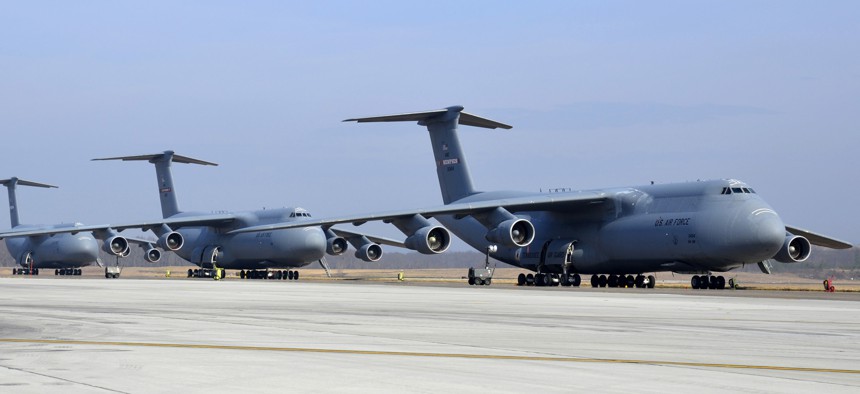
Three U.S. Air Force C-5 Galaxy cargo aircraft sit lined up on the flightline at Westover Air Reserve Base, Mass. Senior Airman Kelly Galloway/USAF
The US Air Force Is Adding Algorithms to Predict When Planes Will Break
The airlines already use predictive maintenance technology. Now the service’s materiel chief says it’s a “must-do for us.”
The U.S. Air Force has started to use algorithms to predict when its aircraft will break, part of an effort to minimize the time and money they consume in the repair shop. The use of predictive analytics has been blazed by airlines, which monitor their fleets’ parts in an effort to replace broken components just before — and crucially, not after — they break.
“I believe it is a must-do for us,” said Gen. Ellen Pawlikowski, the head of Air Force Materiel Command, the arm of the Air Force that oversees the maintenance of its planes. She spoke Tuesday at a Defense Writers Group breakfast in Washington. “We see this as a huge benefit.”
If the Air Force could reduce the risk of unexpected breakage — and the attendant need to fly replacement parts and repair crews around the globe — it could reduce costs and boost mission effectiveness. It could also increase the usefulness of the current fleet by reducing the number of aircraft that need to be be held in reserve as backups.
It starts with gathering data, such as the temperature of engine parts or the stresses on the airframe.
“We are trying to leverage what we already get off of airplanes, as opposed to trying to go in and put instruments in places,” Pawlikowski said. “It turns out there’s quite a bit that’s there, but it may not be a direct measurement. In order to measure the temperature in this one particular spot, I’m getting information somewhere else.”
Artificial intelligence and machine learning can then determine patterns.
The general said the Air Force has been learning a lot from Delta, the world’s second-largest commercial airline. “Delta has demonstrated the effectiveness of predictive maintenance in dramatically reducing the number of delays to flights due to maintenance,” she said.
Over the past three years, Air Mobility Command — the arm of the Air Force that oversees all of its large cargo planes and aerial refueling tankers — has been organizing the data it collects on some of its planes. It has started using the predictive maintenance technology on its massive C-5 airlifters.
The Air Force is also using the technology on the B-1 bomber. “The B-1 is an airplane that we actually bought with a whole bunch of data that we weren’t using,” Pawlikowski said. “We started to take that data in and start to analyze it....We’re very excited about this because we see huge potential to improve aircraft availability and drive down the cost.”
She said she “was impressed when I saw some of the data that they were showing me.”
The Air Force Lifecycle Management Center, which reports to Pawlikowski, has been funding these trials “by finding the loose change in the seat cushions,” she said.
“As we have now shown some things … we’re seeing more and more interest in it and we’re looking at increasing the investment in that to bring it further,” Pawlikowski said of the predictive maintenance.
Last September, Gen. Carlton “Dewey” Everhart, head of Air Mobility Command, stressed his desire to use predictive maintenance, but warned it would cost money to get the data from the companies that make the planes.
“In some cases, we’ll be working this collaboratively with our industry partners,” Pawlikowski said Tuesday. “In other cases, we’ll be doing it completely organically.”
Air Mobility Command is also using predictive maintenance technology on the C-130J airlifter. The latest version of the venerable Lockheed Martin cargo plane — the J model — collects reams of data as it flies. In April, the Lockheed announced it was teaming with analytics firm SAS to crunch that data.
“Everything we’ve been doing up to a certain point has been looking in the rear-view mirror with the data,” said Lockheed’s Duane Szalwinski, a senior manager with his company’s sustainment organization who specializes in analytics. “We’re going to be able to look forward.”
Lockheed is working on a six-month demonstration for Air Mobility Command; officials hope to be able to predict when certain parts will break before a flight.
“If we’re able to do that, it kind of changes the game in how you maintain and operate a fleet,” Szalwinski said.
The data will give military planners a wealth of information about their aircraft that could help determine the best aircraft to deploy. “All those things you now know you have insights as to what you will need at the next flight, so you act accordingly,” he said.
“Once we prove that we understand the probability of failure of these parts … all things then become possible,” Szalwinski said. “Now it’s not a matter of if, it’s a matter of when. And if you know when, you can start acting accordingly. It would be a gamechanger in the way you manage a fleet.”
Lockheed also wants to use the predictive maintenance tech on the F-35 Joint Strike Fighter.
“The beauty of this is that the toolsets that we’re developing, the models, how we clean the data, how we build the models, how we build the algorithms, all of that is not unique to a platform,” Szalwinski said.
Still, instituting predictive maintenance practices fleet-wide is not going to happen overnight, particularly as since it will take time to understand the data, Pawlikowski said.
Using this technology will require a cultural shift among maintenance crews because they’ll be replacing parts before they actually fail, Pawlikowski said.
“One of the big benefits is the reduction in the amount of time the airmen on the flightline spends troubleshooting a broken part” because “we will take them off before they break,” she said.




